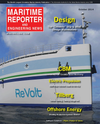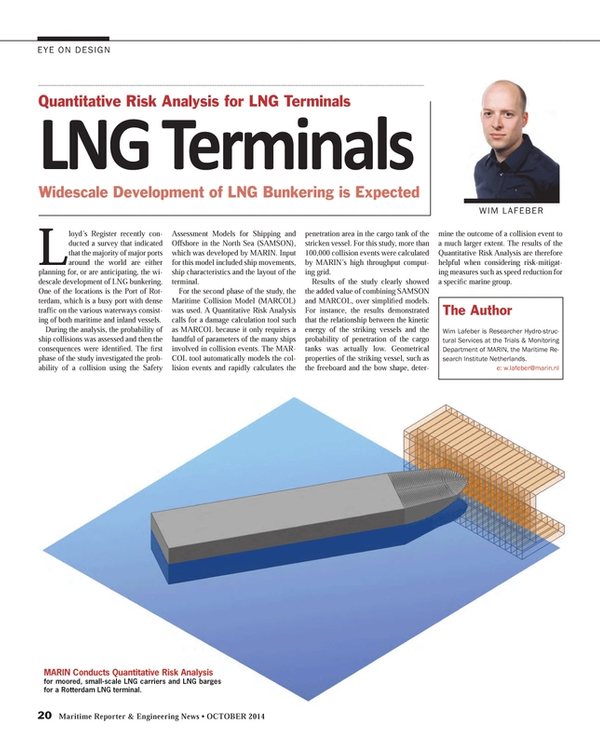
Quantitative Risk Analysis for LNG Terminals
Widescale Development of LNG Bunkering is Expected.
Lloyd’s Register recently conducted a survey that indicated that the majority of major ports around the world are either planning for, or are anticipating, the widescale development of LNG bunkering. One of the locations is the Port of Rotterdam, which is a busy port with dense traffic on the various waterways consisting of both maritime and inland vessels.
During the analysis, the probability of ship collisions was assessed and then the consequences were identified. The first phase of the study investigated the probability of a collision using the Safety Assessment Models for Shipping and Offshore in the North Sea (SAMSON), which was developed by MARIN. Input for this model included ship movements, ship characteristics and the layout of the terminal.
For the second phase of the study, the Maritime Collision Model (MARCOL) was used. A Quantitative Risk Analysis calls for a damage calculation tool such as MARCOL because it only requires a handful of parameters of the many ships involved in collision events. The MARCOL tool automatically models the collision events and rapidly calculates the penetration area in the cargo tank of the stricken vessel. For this study, more than 100,000 collision events were calculated by MARIN’s high throughput computing grid.
Results of the study clearly showed the added value of combining SAMSON and MARCOL, over simplified models. For instance, the results demonstrated that the relationship between the kinetic energy of the striking vessels and the probability of penetration of the cargo tanks was actually low. Geometrical properties of the striking vessel, such as the freeboard and the bow shape, determine the outcome of a collision event to a much larger extent. The results of the Quantitative Risk Analysis are therefore helpful when considering risk-mitigating measures such as speed reduction for a specific marine group.
The Author
Wim Lafeber is Researcher Hydro-structural Services at the Trials & Monitoring Department of MARIN, the Maritime Research Institute Netherlands.
e: [email protected]
(As published in the October 2014 edition of Maritime Reporter & Engineering News - http://magazines.marinelink.com/Magazines/MaritimeReporter)
Read Quantitative Risk Analysis for LNG Terminals in Pdf, Flash or Html5 edition of October 2014 Maritime Reporter
Other stories from October 2014 issue
Content
- They Said It ... Paul N. Jaenichen, U.S. Maritime Administrator page: 11
- Cutter Suction Dredge CSD500 from Damen page: 18
- Quantitative Risk Analysis for LNG Terminals page: 20
- Offshore Supply Vessels: The U.S. Can Compete page: 22
- New Solutions for Electric Ship Propulsion page: 24
- Classic Design with Tomas Tillberg page: 28
- Innovative Enviroship Concept Wins Big page: 30
- Design (R)Evolutions page: 32
- Condition Based Monitoring & Saving Cash page: 38
- HVAC Systems: The Stealthy Drain on Energy Efficiency page: 50
- What’s New in Floating Production? page: 52
- SSI Releases ShipConstructor 2015 page: 54
- SENER Releases FORAN V70R3.0 page: 56
- MAN Diesel & Turbo Debuts New High-Speed Engine page: 58
- VULKAN Couplings Debuts New Products page: 59
- Cat Unveils MaK M 25 E Platform page: 60
- ZF Marine Debuts ZF W10000 Transmission page: 61
- Wärtsilä’s New CPP System page: 61
- Hatz Presents New Engine Concept Study page: 62
- Schottel Shifts Focus Offshore at SMM 2014 page: 62
- Wärtsilä’s LNGPac: AIP from DNV GL page: 63
- GreenSteam Optimizer on Display page: 63
- Leistritz Debuts Three New Pumps page: 64
- Van Heck Advances Dredging Innovation page: 65
- Georg Fischer Piping DWV Fittings page: 65
- Bestobell Extends Valve Range page: 65
- Teekay Couplings Plastlock Pipe Coupling page: 66
- W&O Actuated Valve Solution for Vigorous page: 66
- Alfa Laval Launches PureSOx 2.0 page: 67
- Meet the Transas T-Bridge page: 68
- New Waste Energy Converter from Calnetix page: 68
- GAC’s EnvironHull HullWiper on Display page: 68
- BMT Showcases Monitoring Portfolio page: 68
- GEA’s CatFineMaster Debuts at SMM page: 70
- Engine Supervision and Management Software page: 70
- GPS-controlled Food Waste Discharge page: 70
- New Raytheon Anschütz Navigation Radar page: 70
- Raytheon Anschütz ShipGuard page: 71
- GNS Launches First VMS page: 71
- Revamped XChange page: 71
- GEA Heat Exchangers page: 71
- WR On-stack Scrubber Emission Monitor page: 71
- Improved Controller for Rexroth AHC page: 71
- NavStation Launched at SMM page: 71
- Wild Well’s Subsea Capping Stack page: 71
- Kelvin Hughes Product Range Expands page: 71


